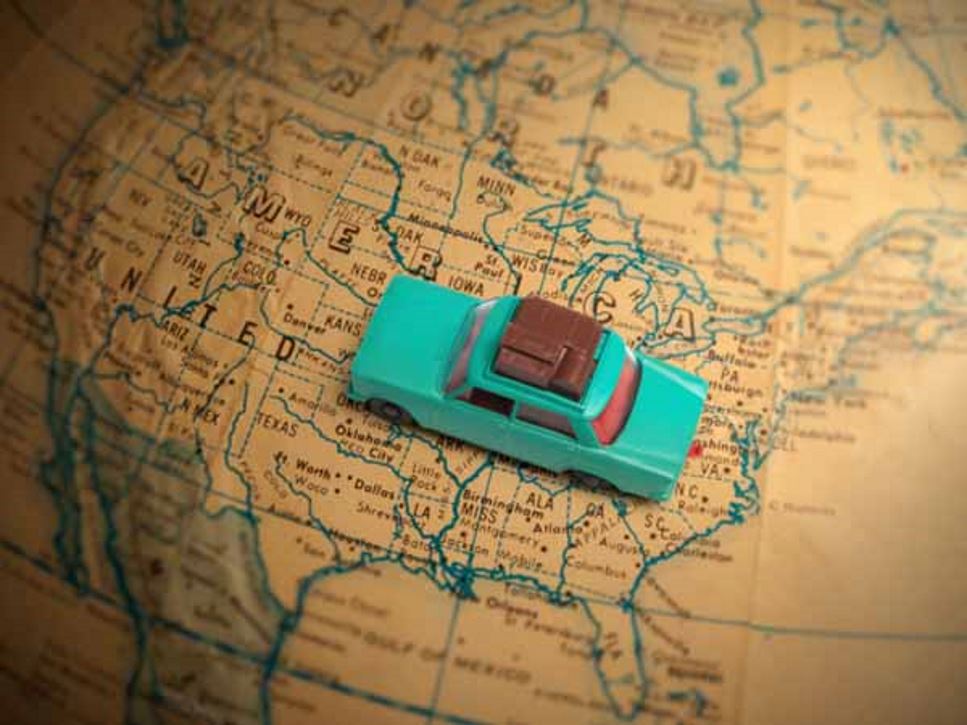On the road? Travel can be exciting, educational, exhausting and energizing! And, the food you enjoy while traveling can be delicious and memorable. Print this quick guide and refer to it while packing and traveling to help you eat right while traveling in the U.S.
Before You Go, Pack Foods with Care
- Clean your produce. Rinse all fresh produce under running tap water before packing it in a cooler, including produce with peel-away skins or rinds.
- Keep cold food cold. Place cold food in coolers with frozen gel packs or ice. Stashing it at 40°F or below prevents bacterial growth. Consider packing beverages in one cooler and perishable foods in another since you are likely to grab beverages most often, opening the cooler more frequently. Sliced fruit and veggies, hummus, guacamole and yogurt are good snacks to store in the other cooler.
- Keep hot food hot. That means your best bet when packing is to take a pass on hot food unless you have a portable heating unit that can be used safely.
- Pack healthy non-perishable snacks. No matter if you’re traveling by land, air or sea, your family can eat healthfully with these simple options:
- Whole or dried fruit.
- Nuts (pre-portioned into snack-size bags).
- Nut butters (travel packs are great for planes).
- Whole-grain pretzels, crackers and bread sticks.
- Trail mix.
- Snack bars. Look for bars made with whole grains, nuts and fruit and with minimal amounts of added sugars.
- Carry hand sanitizer and disinfectant wipes. These come in handy for washing your hands or other surfaces when you’re on the go and don’t have easy access to running water.
Once You're Off, Keep Food Safety in Mind
- Clean your hands before you eat. Even if you don't need to use the restroom, you'll still want to wash away germs you picked up in the airport or train station. Wash with soap and water or hand sanitizer.
- Be safe with water. Water is regulated and tested throughout the U.S., but, when in doubt, don't drink the tap or well water. This also goes for anything made with water, such as ice or fountain drinks. Stick with sealed, bottled beverages if you have any concerns about the local water supply.
- Remember the two-hour rule. If you buy cold or hot food at the airport or train station, eat it within two hours of purchasing. After that, bacteria multiply. (In hot weather, the safe time limit is one hour.) Set a timer on your watch or phone to remind you.
- Think before eating. On the plane, clean off your tray table with disinfectant wipes. Never set food directly on the tray table. If hot food is served on the plane or train, make sure it is, indeed, hot.
Eat Right While Traveling
- Choose healthy snacks. These choices are easy to carry and are available in many gas station marts and airport terminals:
- Part-skim mozzarella cheese stick.
- Whole-grain sandwich with lean meat, vegetables and mustard.
- Salad with lean protein.
- Vegetable soup.
- Fat-free latte.
- Fruit cup.
- Pre-cut veggies.
- Markets. Pick up pre-washed/pre-cut vegetables, hummus, yogurt, sandwiches, salads and fruit with peels including oranges and bananas.
- Sandwich shops. Choose whole-grain bread, extra vegetables and mustard instead of oil or mayo.
- Drive-thrus and casual restaurants. Focus on items that are grilled, steamed, broiled or baked instead of fried or sautéed. Consider salads with lean protein and a vinaigrette-based dressing, broth-based soups, oatmeal and eggs with whole-grain bread. If you're craving comfort food, just watch your portions — stick to the basics such as a single burger patty without special sauces, kid-size sides and water instead of soda.
At Your Destination, Seek Out Healthy Bites
- At a hotel, ask for a room with a mini-fridge. Then visit the local market for grocery staples. That way you can keep healthful items on hand for snacks or breakfast.
- Be cautious about continental breakfasts. It’s not uncommon for hotel breakfast bars to be stocked with cereals with large amounts of added sugar, pastries and other suboptimal choices. If your hotel offers this complimentary meal, go ahead and scope it out, but look for whole-grain cereals with fat-free or low-fat milk, fruit or yogurt.
- Beware of buffets. Before you grab a plate, walk around the buffet and decide which foods you'll choose. Steer clear of any food that's served at room temperature — that's within the temperature "danger zone" where bacteria can thrive. Aim to make half your plate fruits and vegetables, one-quarter lean protein and one-quarter whole grains.
Find a Nutrition Expert
Looking for credible nutrition information and recommendations? The Academy of Nutrition and Dietetics' network of credentialed food and nutrition practitioners are ready to help!

